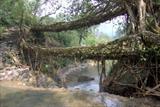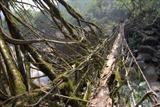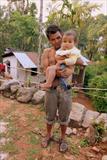I awoke feeling greatly refreshed. The crisp mountain air and satisfyingly solid mattress ensured a good night's sleep. I think I earned it after the tumultuous trip I'd had so far, being driven around by caffeine-fueled maniacs. I was also granted a reprieve from further torment as the sun shone on a beautiful day in a region commonly known as the "Wettest place on Earth".
I was greeted warmly by my hosts, Dennis and Karmela, as I sat in the central hall (that all the rooms in the circular building of the Cherrapunjee Holiday Resort opened onto) and served a full breakfast including a delicious helping of porridge. They were some of the most hospitable people I've met on this trip and I would highly recommend the place (although I would caution that it's best to arrive here during light if possible as the mountain road is, at best, hair-raising). The staff are all employed from the local villages and as the day progressed, I was to learn that a lot of the tourist infrastructure around here was largely organised and funded by philanthropic Dennis himself. A former banker, Dennis "discovered" the living root bridges (the reason for my trip here) during a hiking trip and brought them to the world's attention by building the holiday home, and aided the development of the local villages you pass on the trek (concrete paths and water pipes, etc). Ironically, the remote "resort" (essentially a large bungalow) also had one thing that most other mainstream hotels in India didn't have: WiFi! A huge satellite dish sits atop the building.

Double Decker root bridge
Before I had decided to visit India, I'd never even heard of the "living root bridges": a collection of bridges spanning river rapids that are formed entirely from rubber-tree roots. They have been created for over 1,000 years by the local hill tribes who noticed how powerful the roots were and saw them as an opportunity to easily cross the area's many rivers. Whenever a rubber tree was spotted growing beside a river, betel nut vines were sliced down the middle and hollowed out to be used as root-guidance systems. The rubber-tree roots were then "led" across the river, through these vines, to take root on the other side. After only 10-15 years the roots would grow strong enough to support the weight of 50 people at a time! It's a continuous process: as one bridge begins to fall apart another one is built in tandem to take over when the former gives up the ghost.

Huge living root bridge
It was only after some quick googling about the North East states that it came up as a "must-see" attraction. This morning though, as I stepped out of the bungalow to survey my surroundings, it quickly became apparent that the area had so much more: From the top of the ridge on which the resort sits you could look down to Bangladesh, the border being only 5km away. At night you could hear prayer-call wafting up through the valley. The area is known as the "Scotland of the East", but with its steep jungle-clad mountains, waterfalls, and South-East-Asian-looking hill tribes, it strongly resembled Sapa in Northern Vietnam. It is a stunning area to visit.
I knew I was in for an tough day of trekking. The only way to visit the root bridges is to take a 20km trek there and back. This all had to be done before it got too late as a lot of the trail led across precarious rope bridges and into dark jungle. I had my head-torch with me as a precaution.
It was harder than I expected. The 8 hour trek involved a steep 1.5km concrete stair climb in intense humid jungle heat that was on par with the exhausting jungle trek I did in Colombia last year. I counted myself lucky that I was visiting now, as only 4 years earlier before Dennis built the concrete steps and paths that ran through the Khasi villages, this would have been a mud track. Even so, my calf muscles killed me for a few days after.

Khasi villagers
Along the way, I met some of the most charming villagers I have ever encountered. Every single one of them greeted me with big sincere smiles, and a shockingly-good command of English thanks to Welsh missionaries that built a mission here a century ago and converted most of the population to Christianity. Really lovely to be around and, for once, NOT looking at me like a cash-cow (as seemed to be the standard in mainland India). They don't meet many westerners here doing this trek, so the chance for them to practice their English is of paramount importance. Kids would say things like "Hello, how are you?" and even go so far as to shout "I love you!". So many smiles, and not yet jaded by excessive tourism, I put this experience down as one of the best in my entire trip, and I even got to play cricket with some of the school kids.
I also learned a small bit of Khasi: "Chit" meaning "Hot" ... I said that a lot. If it wasn't for the plentiful water-taps in the villages (the water is perfectly clean to drink) and the ample packed lunch that the resort had prepared for me, I would have passed out.
As for the rest of the trek, I felt priviledged to have the whole place to myself (most Indian tourists wouldn't exert themselves on such a trek, preferring to drive to destinations) and felt like Indiana Jones as I crossed precarious rope bridges (they're actually made of "wire-rope" so not too dangerous) in a jungle setting and uncovered hidden living root bridges that would otherwise not be seen (you only need to cross about 3 living root bridges on the trek, yet there are many more in the valley that you can spot). Some of the living root bridges span about 30 metres, and it's really quite amazing to see how the roots entangle over each other so that the bridge gets stronger as each year passes.
The waterfalls and river rapids that you had to cross using the bridges led into refreshing water holes that you could swim in. One particular water hole that I liked was at the "Double Decker" bridge (so named by Dennis) was absolute bliss in the heat of the jungle, with a jacuzzi-like effect from a small waterfall. I thought I had found the Fountain of Youth, as I felt like I was 10 years younger.
The only bad experience I had was when a kid demanded 10 Rs off me to see the Double Decker bridge. He had stamped receipts so that it looked official, but apparently this was something that Dennis had arranged with the local villages so that they could get something from the burdgeoning tourist industry here. I didn't know I'd have to pay so didn't have any cash on me...
As night fell and I stumbled back to the resort, I was accomanied by a disco-ball of fire-flies...and finally I somehow made it back. I had to change rooms as my room had been pre-booked by another Indian "extended-family tourist group" (as seen in Khaziranga). The new room was in the basement of an unfinished house adjoining the bungalow and was chock-full of huge spiders. I was so tired after the trek that after trapping the 6th spider I gave up, rubbed my blistered feet, and conked out.